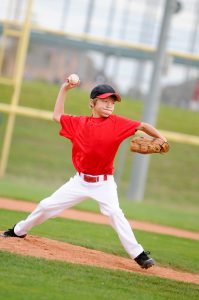
According to The American Journal of Sports Medicine, more than 15 million people will be playing baseball and softball this spring and summer, nearly 5.7 million of which are children in eighth grade or lower. Dr. Michael Saper, an orthopedic surgeon and sports medicine specialist at Seattle Children’s, has some useful information about how young players can avoid arm injuries.
Before joining Seattle Children’s, Saper trained under Dr. James Andrews, a renowned orthopedic surgeon who has treated many professional athletes, including hall of fame pitchers Nolan Ryan and John Smoltz. It was in working with Andrews that Saper developed his passion and expertise for the treatment and prevention of throwing elbow and shoulder issues.
Saper noticed injuries that were common in high-level athletes occurring in younger athletes and realized that education about how to stay healthy is just as important as treating the patient after a serious arm injury occurs.
Preventing injuries due to fatigue
In recent years, proactive measures have been implemented in both little league and high school sports to limit the number of pitches athletes can throw in a given game or week. Those regulations follow studies that have shown higher injury rates associated with increased innings pitched. A study in the American Journal of Sports Medicine found that younger fatigued pitchers are 36 times more likely to suffer an injury than those without arm fatigue.
Saper suggests several tips to prevent such injuries:
- Young pitchers should not also play catcher due to the volume of throwing at each position.
- Rest is key. If the arm is feeling tired, pay attention to the signs and reduce throwing.
- Warm-up adequately before pitching at game speeds.
- Vary the sports that a child is involved in to give the arm time to rest throughout the year.
- Kids should only play in one league at a time to avoid overuse and fatigue.
- Wait on throwing pitches other than fastballs and changeups until the child reaches skeletal maturity.
- Follow pitch count limitations and rest requirements in between outings.
- According to the official little league website, the recommended maximum pitch counts by age are as follows:
- 13-16: 95 pitches per day
- 11-12 : 85 pitches per day
- 9-10: 75 pitches per day
- 8 and younger: 50 pitches per day

Common injuries and their treatment
There are two main arm injuries that Saper sees among young athletes: Medial epicondylitis, often called “little leaguers elbow”, and ulnar collateral ligament tears, which are common among more advanced athletes. What concerns Saper the most is that the age of children with these injuries is getting progressively younger. Over the past decade, shoulder injuries have decreased but the injuries to elbows have been on the rise. He attributes this to multiple factors including year-round sports seasons and what he calls “showcases” where young athletes are trying to impress coaches and scouts by throwing harder and longer than usual.
Saper’s philosophy is to educate patients and intervene before injuries require surgery. According to Saper, surgery doesn’t guarantee a patient will return to the same level of play they were at before their injury.
“Surgery is not 100%, but more like 70% to 85% in terms of the patient’s ability to return to their performance level before the injury,” said Saper.
The importance of rest
The main prescription offered for throwing related injuries is a simple one: rest.
“The more a child tries to play through the pain or discomfort of an injury, the worse the injury will become,” said Saper. “It’s important to address throwing injuries early on so we can treat them and avoid invasive surgeries.”
Saper also recommends children don’t play year-round throwing sports without rest.
“Kids often don’t have an off-season, and when they do switch sports, they’re playing a position like quarterback so they’re still throwing instead of resting,” said Saper.
When Saper meets with a patient, he first talks to the athlete before ordering any tests.
“I ask them about their throwing history, the number of innings they pitch and other risk factors,” he said.
Only after he assesses the patient’s throwing habits does Saper determine whether additional tests like MRIs are necessary. Many times, the injury can be treated with rest, physical therapy and a formal throwing program.
Advice for athletes
Saper urges kids to focus on mechanics, not velocity.
“There is a temptation for young athletes to throw as hard as possible,” said Saper. “Unfortunately, that is precisely the type of repetitive stress that leads to injury.”
Saper is a strong advocate for proper throwing mechanics, particularly for children under the age of 16 whose core and leg strength may not be developed. In addition, Saper advises young athletes to give their arms adequate rest time between sports seasons.
It is Saper’s goal to work with children early on to utilize non-surgical techniques for arm recovery. If a child is experiencing elbow or shoulder issues, the best advice is to tell coaches and parents right away.
“The bottom line is that early diagnosis is key to helping avoid surgery,” said Saper.
Resources:
- Orthopedics and Sports Medicine
- Doctor Offers Tips to Prevent Overuse Injuries
- Little League Shoulder
- Rotator Cuff Tendonitis

